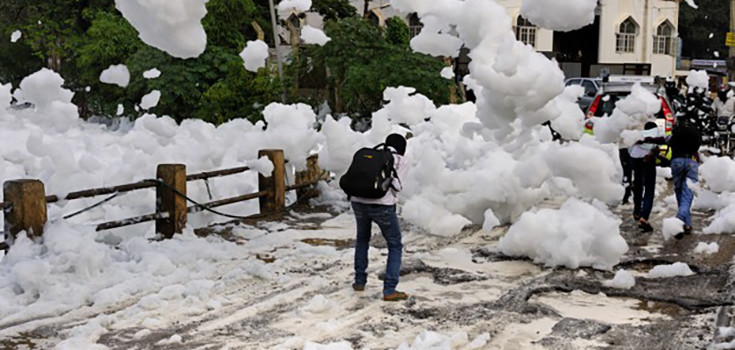Town in India Invaded by Toxic Waste Clouds
Town in India Invaded by Toxic Waste Clouds
The result of a toxic stew of chemicals in the lakes
( Natural Society ) Fluffy white clouds of toxic waste have invaded the streets of Bangalore.
) Fluffy white clouds of toxic waste have invaded the streets of Bangalore. It looks like fresh snow, but it’s actually from the Bellandur Lake, which is horribly contaminated with chemical and sewage waste. When it rains, the lake rises and winds lift the foam into the sky and carry it to India’s technology capital.
The city used to be home to nearly a thousand lakes, but now only about 150 exist. Thanks to the pollution, Bangalore has earned a new nickname: the “land of a thousand sewage tanks.”[1]
Bellandur Lake used to supply more than 20 villages with water until the 1970’s, but it has since become a cesspool. It is part of the Bellandur drainage system and it drains into the southern and southeastern part of the city.
Digital Journal reports thatby the 1980s, unregulated industrial, residential and commercial development caused insufficient rainwater to reach the Bellandur Lake. The body of water declined further in the 1990s, when Bangalore became India’s version of Silicon Valley. As IT companies moved into the city, the lake became a dumping ground for construction debris, leading increased dumping of chemical wasteand raw sewage into the water, and a buildup of the toxins around the lake.
“Bangalore, India was once known for its interconnected lake systems which provided a reliable source of water. As the city grew these lakes were encroached and the water became polluted day by day. The largest Bellandur Lake in Bangalore now carries huge volume of snowy froth which blocks the adjacent canals. This froth which would otherwise been a sight to behold stinks and on contact with skin causes irritation. Following a heavy rain the froth from the canal rises up and lands on the roads causing inconvenience to those travelling on two wheelers. This is a major concern with many such lakes in Bangalore which are getting polluted with harmful chemicals like nitrates, potassium, sulphates, etc.”
The once-popular family recreation area is now a fenced-off area, with water so toxic that people who come into contact with it develop skin rashes and burning eyes. The foam is the result of very high levels of ammonia and phosphorus and oxygen-depletion.
The foam, which can reach up to more than 3 feet on roadsides, reduces disability and clings to cars, cyclists and pedestrians, and produces a putrid stench that burns the nose. But most terrifying, the foam is flammable. The lake itself occasionally catches fire due to the grease, oil, and detergents found in the foam. This occurred in May and June, resulting in a 56-year-old man standing on a bridge above the lake suffering a ruptured cornea. [3]
Fed up with the stench and health risks, Bangalor residents are trying to take back their city and their previously beautiful lake. Techie Sanchita Jha started an online petition3 weeks ago at Change.org demanding that Bellandur Lake be cleaned up. So far, Jha has collected more than 15,000 signatures. Aquatic life in the lake has died off, Jha states in the petition. The wetlands around the lake have vanished and much of the wildlife has disappeared. A Facebook page has also been set upto raise awareness about the lake’s plight.
According to Jha, two university students who went to Bellandur Lake to obtain samples wound up with skin rashes and severe vomiting after being near the site for approximately 30 minutes.
“The samples showed extremely high levels of E. coli. While the optimum range for E. coli is less than 100, Bellandur Lake’s water has it in the range of 717-916,” she said. “The normal range for Phosphates is 0.2, but the figure has touched 2.6. That is how bad it is,” Jha says. [4]
Documentary photographer Debasish Ghosh has taken to the streets to capture images of the noxious, creeping foam, making sure to clean his arms, hands and face any time he gets too close to the contaminated clouds. Ghosh claims that the government has done little to satisfy the countless complaints from locals. He says that after the BBC published the photos, the government paid a bit more attention, but all they’ve done is try to prevent the foam from floating around and landing on people.
“What happens is the water [mixes with] the foam at a high speed, and it disintegrates and doesn’t rise up,” says Ghosh. “That’s how they are controlling it at this point in time, so it doesn’t fall on people.”
According to Ghosh, even if the government does decide to take the complaints and petition seriously, the cleanup won’t be easy and it certainly won’t be quick.
“There’s so much pollution that it will take lots of time and lots of investment to bring this lake back to normal,” he says. “To what it was maybe two decades ago, when people say there would still be migratory birds in there.”
Featured image credit: Debasish Ghosh
| About Julie Fidler: | |
| Julie Fidler is a freelance writer, legal blogger, and the author of Adventures in Holy Matrimony: For Better or the Absolute Worst. She lives in Pennsylvania with her husband and two ridiculously spoiled cats. She occasionally pontificates onher blog. | |
Other Popular Stories:

Post a Comment